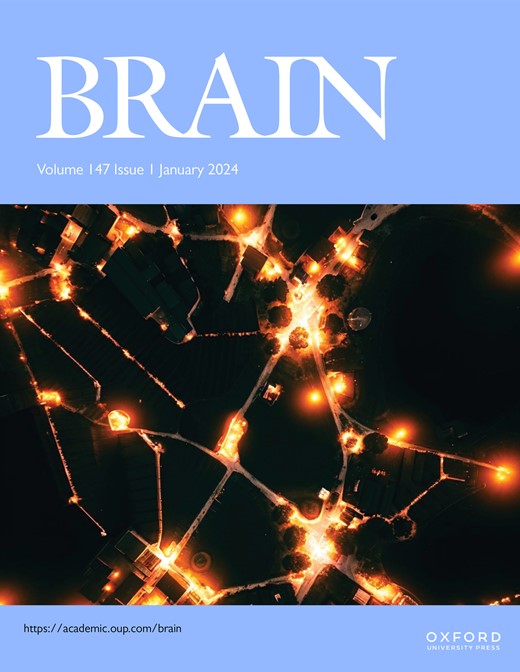C21ORF2突变指向肌萎缩性侧索硬化症的原发性纤毛功能障碍
IF 10.6
1区 医学
Q1 CLINICAL NEUROLOGY
引用次数: 0
摘要
运动神经元的进行性丧失是神经退行性疾病肌萎缩性脊髓侧索硬化症(ALS)的特征,但其潜在的疾病机制仍不完全清楚。在这项研究中,我们调查了最近与 ALS 有关的基因 C21ORF2 突变的影响,发现原发性纤毛功能障碍。源自人类患者的突变型 C21ORF2 运动神经元的纤毛频率和长度减少。我们报告说,C21ORF2 位于初级纤毛的基底体,而与渐冻症相关的基因突变改变了这一定位。此外,我们还发现,细胞系和运动神经元中 C21ORF2 水平的降低足以导致初级纤毛减少和纤毛长度缩短。这种纤毛功能障碍会导致下游声刺猬信号的缺陷,并降低细胞视黄酸结合蛋白1(CRABP1)的表达,而CRABP1是一种参与运动神经元维持和存活的蛋白质。在运动神经元和肌肉细胞的分区共培养系统中,这些纤毛缺陷与神经肌肉接头形成能力下降有关。有趣的是,这些纤毛缺陷似乎并不局限于 C21ORF2 ALS,因为我们还在培养的运动神经元和因 C9ORF72 基因重复扩增而导致的 ALS 最常见遗传亚型患者的死后运动皮层中观察到了初级纤毛紊乱。最后,在突变型 C21ORF2 运动神经元中过表达 C21ORF2 可修复纤毛频率和长度、CRAPBP1 表达和神经肌肉接头的形成,这证实了初级纤毛对运动神经元功能的重要性。这些结果表明原发性纤毛功能障碍是导致渐冻人症运动神经元变性的原因之一,并为进一步研究和干预这种尚无法治疗的疾病开辟了新途径。本文章由计算机程序翻译,如有差异,请以英文原文为准。
C21ORF2 mutations point towards primary cilia dysfunction in amyotrophic lateral sclerosis
Progressive loss of motor neurons is the hallmark of the neurodegenerative disease amyotrophic lateral sclerosis (ALS), but the underlying disease mechanisms remain incompletely understood. In this study, we investigate the effects of C21ORF2 mutations, a gene recently linked to ALS, and find that primary cilia are dysfunctional. Human patient-derived mutant C21ORF2 motor neurons have a reduced ciliary frequency and length. We report that C21ORF2 is located at the basal body of the primary cilium, and mutations associated with ALS alter this localization. Furthermore, we show that a reduction of C21ORF2 levels in cell lines and motor neurons is sufficient to cause fewer primary cilia and reduced cilial length. This ciliary dysfunction leads to defective downstream sonic hedgehog signalling and reduces the expression of cellular retinoic acid binding protein 1 (CRABP1), a protein involved in motor neuron maintenance and survival. In a compartmentalized co-culture system of motor neurons and muscle cells, these ciliary defects were associated with a reduced ability of neuromuscular junction formation. Interestingly, these cilia defects are seemingly not restricted to C21ORF2 ALS, as we also observed perturbed primary cilia in cultured motor neurons and post-mortem motor cortex from patients with the most common genetic subtype of ALS caused by repeat expansions in the C9ORF72 gene. Finally, overexpression of C21ORF2 in mutant C21ORF2 motor neurons rescued the ciliary frequency and length, CRAPBP1 expression and neuromuscular junction formation, confirming the importance of primary cilia for motor neuron function. These results point towards primary cilia dysfunction contributing to motor neuron degeneration in ALS and open new avenues for further research and interventions for this as yet untreatable disease.
求助全文
通过发布文献求助,成功后即可免费获取论文全文。
去求助
来源期刊

Brain
医学-临床神经学
CiteScore
20.30
自引率
4.10%
发文量
458
审稿时长
3-6 weeks
期刊介绍:
Brain, a journal focused on clinical neurology and translational neuroscience, has been publishing landmark papers since 1878. The journal aims to expand its scope by including studies that shed light on disease mechanisms and conducting innovative clinical trials for brain disorders. With a wide range of topics covered, the Editorial Board represents the international readership and diverse coverage of the journal. Accepted articles are promptly posted online, typically within a few weeks of acceptance. As of 2022, Brain holds an impressive impact factor of 14.5, according to the Journal Citation Reports.
 求助内容:
求助内容: 应助结果提醒方式:
应助结果提醒方式:


